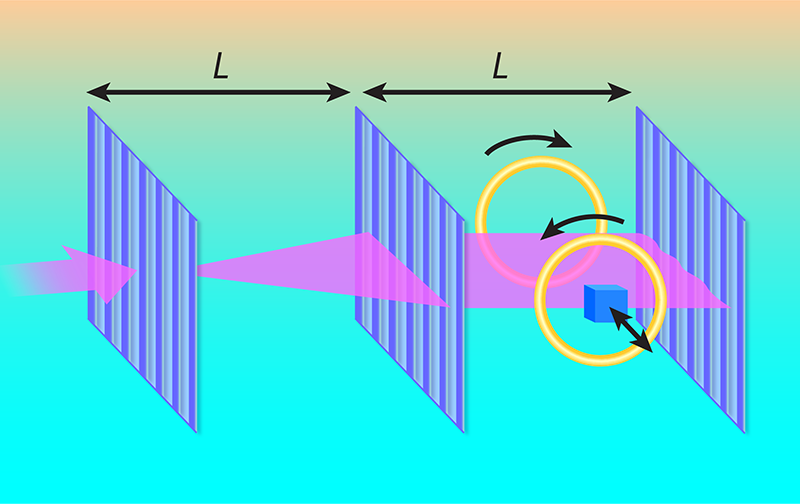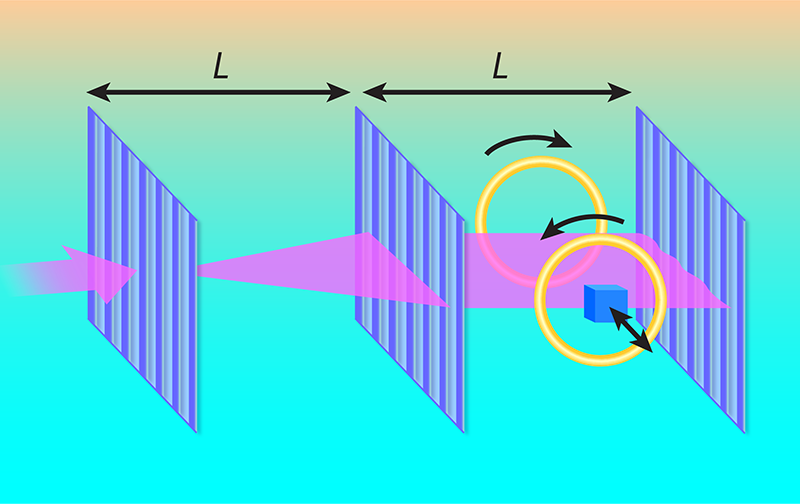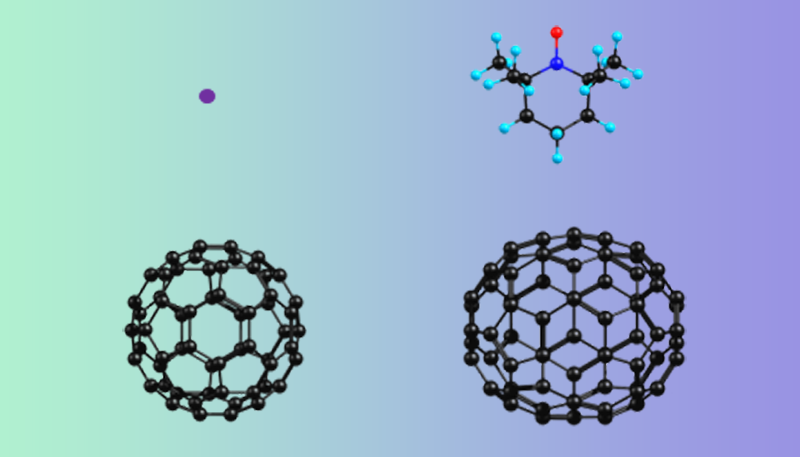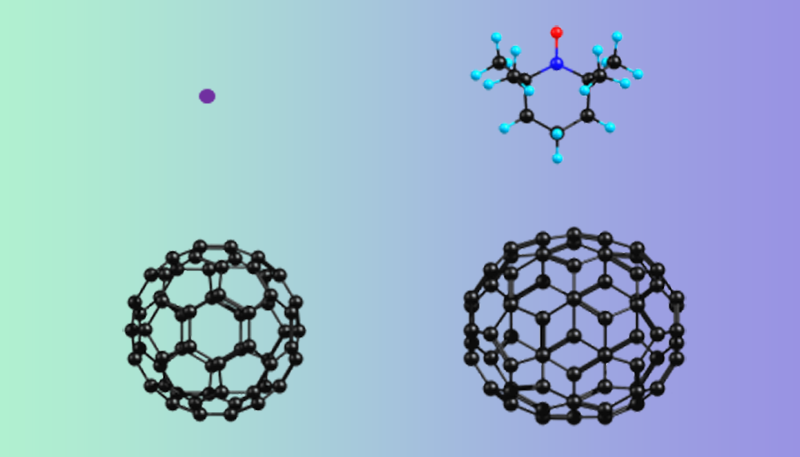Probing Molecular Magnetism Interferometrically
This year marks the centenary of the ground-breaking experiment of Otto Stern and Walther Gerlach that demonstrated the quantization of the spin angular momentum of an atom [1]. The evidence came from the observation that a beam of silver atoms, upon traversing a spatially varying magnetic field, split into two beams. The spatial splitting of the spin-up and spin-down atoms corresponded to an atomic magnetic moment of 1 Bohr magneton—the magnetic moment of a single spinning electron. The deflection of particle beams in a spatially varying magnetic field remains the basis of techniques for characterizing the magnetic properties of isolated atoms and molecules. Such techniques, however, aren’t sufficiently sensitive to study very large, weakly magnetic molecules, including many biological molecules. Now a team led by Markus Arndt at the University of Vienna has developed a Stern-Gerlach matter-wave interferometer that can resolve nanometer-scale deflections [2]. This “universal” interferometer is applicable to species with vastly different magnetic moments, ranging from a Bohr magneton down to less than a nuclear magneton—about 1/1836 of a Bohr magneton. These features allowed the researchers to use the same interferometer to study cesium atoms and large molecules, including an organic free radical and weakly magnetic fullerenes.
Stern and Gerlach’s historic experiment involved an intense, collimated atomic beam, a spatially varying magnetic field, and a position-resolving detector that measured the transverse spatial distribution of the outgoing atomic beams. This configuration produced a beam deflection whose magnitude scaled inversely with the mass of the particles, making it difficult to measure the small deflections that heavy particles would undergo [3].
A major advance came six decades later when physicist David Pritchard and his group at the Massachusetts Institute of Technology diffracted an atomic beam from an optical standing-wave grating [4] and later from a nanomechanical grating [5]. This allowed an atomic beam to be split and recombined coherently to realize the first atom matter-wave interferometer [6]. Matter-wave interferometry offered the possibility to greatly enhance the sensitivity of techniques for probing the magnetism of isolated atoms and molecules [7].
In 1999, Arndt and colleagues demonstrated the diffraction of the most massive objects to that date, C60 fullerene molecules, which scattered off a 100-nm-period transmission grating [8]. With a de Broglie wavelength of the C60 molecules of only about 1 picometer and diffraction angles of about 10 microradians, the experiment reached the limits imposed by the available beam collimation and by the spatial resolution of the particle detector. Such limits are based on diffraction in the “far field”—that is, on scales much larger than the particle wavelength. Much like in optics, however, working in the “near field” offers the possibility to beat the limits of diffraction. This is the approach followed by Arndt and colleagues in their new work.
The researchers have demonstrated a highly sensitive, universal Stern-Gerlach matter-wave interferometer that can probe magnetism in atoms and in a broad range of large molecular species. The interferometer has a so-called Talbot-Lau configuration with a 2-m-long baseline (Fig. 1) [9]. Such an interferometer consists of three identical and equidistant transmission gratings separated by a multiple of the “Talbot length” (the square of the grating period divided by the de Broglie wavelength). At the third grating, near-field diffraction creates a pattern that is a self-image of the second grating imprinted into the matter-wave beam impinging on the second grating. Between the second and third gratings, either a set of “anti-Helmholtz” coils or a permanent magnet produces a magnetic-field gradient, which in turn causes small trajectory deflections because of the magnetic susceptibility of the molecules. As the third grating is transversely scanned, the multiple trajectories create interference fringes that depend on those beam deflections and that affect the intensity of the matter wave impinging on a detector. Based on the detected intensity, Arndt and colleagues could determine even the smallest deflections (of a few nanometers) associated with the magnetically weakest species under investigation.
The measuring capabilities of the setup stem from two key advantages of a Talbot-Lau near-field interferometer over conventional far-field interferometers. First, such an interferometer has less stringent requirements on the beam’s coherence required to produce high-contrast interference, permitting the use of relatively uncollimated molecular beams and hence a larger throughput. This gain is due to the fact that each slit in the first transmission grating acts as a coherent source for the second grating, with many beam trajectories from the first grating recombining in phase at the position of the third grating and thereby producing a strong signal. Second, the minimum resolvable de Broglie wavelength for near-field diffraction scales as the square of the grating spacing, in contrast to the linear scaling for far-field diffraction. Thus, to detect particles with a tenfold-larger mass, a near-field interferometer requires gratings with only an approximately threefold-smaller grating period—compared with a tenfold-smaller period for a far-field interferometer. These two advantages allow Talbot-Lau schemes with moderately long baselines and easily realizable grating periods to access a very large mass range.
The researchers used their highly sensitive matter-wave interferometer to probe magnetic phenomena in isolated species ranging from atomic cesium—with a single unpaired electron spin—to large molecules (Fig. 2). These molecules included the organic free radical TEMPO and weakly magnetic fullerenes, such as a spherical “soccer ball” molecule (C60), a prolate “rugby ball” molecule (C70), and a molecule with an unpaired nuclear spin (12C6913C). The team obtained, as expected, a weak diamagnetically induced response for C70, corresponding to an induced magnetic moment of about 0.4 nuclear magnetons, and a stronger response for 12C6913C, produced by the nuclear spin, corresponding to 0.7 nuclear magnetons. Surprisingly, the response for C60 was more than 10 times stronger than for C70: about 7 nuclear magnetons. The researchers carried out calculations suggesting that the larger magnetic moment arises because of a large rotational contribution. (Rotational states of C60 up to a quantum number of 466 appeared to be excited. In C70, there is also a rotational contribution, but such a contribution is much smaller because of the lower symmetry of the prolate molecule.)
The new universal Stern-Gerlach matter-wave interferometer should allow researchers to extend matter-wave interferometry to ever larger molecules and to more complex species, including large biological molecules and maybe even living organisms such as bacteria. It should also allow researchers to explore the interface of quantum physics with chemistry, biology, and the macroscopic classical world [3, 10]. There is currently much interest in deciphering the role of molecular magnetism in complex animal phenomena, such as the ability of migratory birds to obtain directional information from Earth’s magnetic field. Finally, precise measurements of magnetic moments will help further our understanding of the magnetism of very massive, complex molecules.
References
- W. Gerlach and O. Stern, “Der experimentelle Nachweis der Richtungsquantelung im Magnetfeld,” Z. Physik 9 (1922).
- Y. Y. Fein et al., “Nanoscale magnetism probed in a matter-wave interferometer,” Phys. Rev. Lett. 129, 123001 (2022).
- S. Gerlich et al., “Otto Stern’s legacy in quantum optics: Matter-waves and deflectometry,” in Molecular Beams in Physics and Chemistry, edited by S. Friedrich and H. Schmidt-Böching (Springer, Cham, 2021).
- P. E. Moskowitz et al., “Diffraction of an atomic beam by standing-wave radiation,” Phys. Rev. Lett. 51 (1983).
- D. W. Keith et al., “Diffraction of atoms by a transmission grating,” Phys. Rev. Lett. 61 (1988).
- D. W. Keith et al., “An interferometer for atoms,” Phys. Rev. Lett. 66, 2693 (1991).
- A. D. Cronin et al., “Optics and interferometry with atoms and molecules,” Rev. Mod. Phys. 81 (2009).
- M. Arndt et al., “Wave–particle duality of C60 molecules,” Nature 401 (1999).
- J. F. Clauser and S. Li, “Talbot-vonLau atom interferometry with cold slow potassium,” Phys. Rev. A 49 (1994).
- M. Arndt et al., “Quantum physics meets biology,” HFSP J. 3 (2009).







